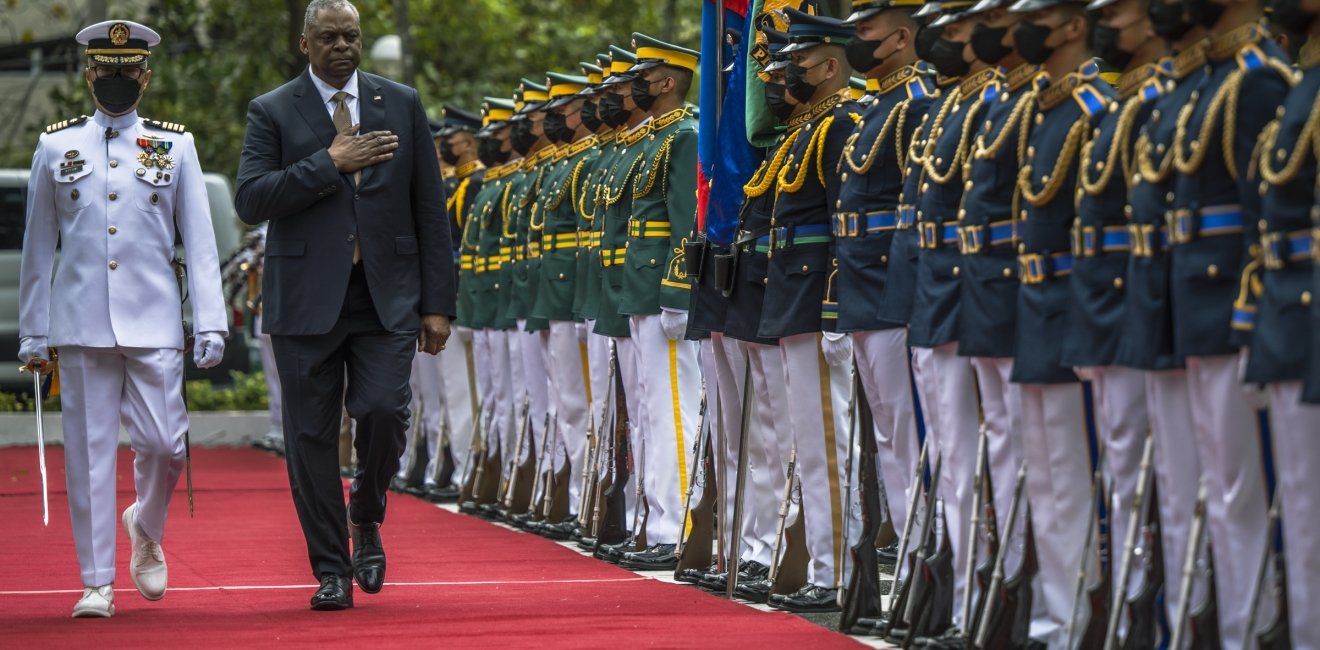
A blog of the Indo-Pacific Program
On April 11th, 2024, US President Joseph Biden will host Japanese Prime Minister Fumio Kishida and the President of the Philippines, Ferdinand Marcos Jr., in Washington, DC for the first US-Japan-Philippines trilateral summit. It aims to reaffirm “the ironclad alliances between the United States and the Philippines, and the United States and Japan.” The expectation is that the trilateral will result in several significant announcements relating to AUKUS, the military structure of the US-Japan alliance, trilateral interoperability, and joint patrols in the South China Sea. Yet, above all, this trilateral is strategically significant not only for its policy announcements, but because it demonstrates another high point in the emerging “latticework” security architecture in the Indo-Pacific.
US mutual defense treaties in the Indo-Pacific have traditionally been “hub-and-spoke,” with each US ally having strong defense ties and alliances with Washington but not each other. This is unlike the collective security approach taken by NATO in Europe, where an attack on one would trigger a response from all.
Relatedly, US relations with its two allies in Southeast Asia have experienced a particularly rocky period during the past decade, as US ties to Thailand remain lukewarm and the previous President of the Philippines, Rodrigo Duterte, had turned towards China. This compounded a traditional overemphasis in US security architecture and force posture on Northeast Asia, meaning that the United States has faced a strategic gap in Southeast Asia since the end of the Cold War. With Taiwan and the South China Sea as potential hotspots, a weak position in Southeast Asia is strategically challenging.
However, under growing multidimensional threats from a revisionist China, the US-Japan-Philippines trilateral signals that the latticework is filling out in Southeast Asia to correct these problems. Importantly, Manila’s own embrace of expanding security ties to other US allies and partners drives this development, lending it a “stickiness” that will ensure it can weather any future challenges in US-Philippines relations.
The Philippines Under Marcos Jr.
The Philippines’ recent shift towards the United States and other allies and partners is a crucial strategic development after years of uncertainty. Upon taking office in 2016, former President Rodrigo Duterte immediately began courting China and threatening aspects of the longstanding US-Philippine alliance. The Philippines’ turn towards Beijing under President Duterte raised serious concerns for observers in Washington.
Yet, Duterte’s efforts largely came to naught. China continued to apply pressure on the Philippines despite Duterte’s attempts to come to some sort of arrangement in the South China Sea, all while promised Chinese economic investment largely failed to materialize. By 2022, Duterte’s efforts to rebalance the Philippines had clearly failed to appease China.
Riding on the outgoing President Rodrigo Duterte’s domestic popularity, Ferdinand Marcos Jr.—the son of an ousted, former dictator—won the Philippines’ 2022 election handily. However, his lack of policy details and ambiguous positioning during the race raised questions about how he would govern.
Yet, upon taking office, Marcos soon quieted concerns about his foreign policy agenda and reversed the Philippines’ course. Facing down continued Chinese gray zone coercion in the South China Sea, he quickly indicated that the Philippines would stand up against China and reembrace its strained alliance with the United States and ties with US allies and partners. Meanwhile, the United States invested heavily in repairing the relationship. This effort resulted in a variety of positive bilateral outcomes, the most significant being the expansion of the Enhanced Defense Cooperation Agreement (EDCA) and reaffirmation of the alliance.
Building a Latticework Around the Philippines
Importantly, building US-Philippines security relations is only one part of a larger picture. Although an Asian NATO isn’t likely, nor are mutually obligated alliance treaties between US allies and partners, we are seeing the development of a latticework security architecture to replace the “hub-and-spoke” model in the Indo-Pacific, thus ensuring “integrated deterrence.”
US Indo-Pacific Strategy aims to forge closer relations between US allies and partners, all while encouraging their own efforts to deepen defense ties. A latticework structure enhances deterrence against China because it closes off opportunities for Beijing to buy off or coerce US allies and partners, deepens and institutionalizes government-to-government cooperation, and ensures that China has to think twice about taking aggressive action in the Indo-Pacific due to the size and depth of any potential coalition against it. Importantly, it extends beyond hard power issues into economic security, cyberspace, the information domain, and other policy areas.
Over the past few years, the Indo-Pacific has witnessed the rise of a variety of security minilaterals and initiatives dedicated to building this out. From the Quad and AUKUS to the US-Japan-South Korea trilateral summit, the region is integrating across all aspects of national security, including defense industrial capacity, joint military exercises, technology development, and more.
Given the Philippines’ strategic location within the first island chain just south of Taiwan and its previous president’s hostility to the United States, Manila’s growing engagement in the latticework is a clear strategic win. Since Marcos began his term, the Philippines and Japan have both pursued the acquisition of long-range ballistic missile capabilities; Manila-New Delhi security relations have improved steadily, as has Manila-Hanoi cooperation; the Philippines and Australia signed a Strategic Partnership in 2023 with clear security implications; and Manila and Tokyo agreed to consider entering a reciprocal access agreement that could enable Japanese troops to operate in the Philippines. Conceptually, these arrangements integrate the Philippines more deeply into Indo-Pacific security architecture and enhance its deterrence against Chinese gray zone coercion. Importantly, this effort is not driven by Washington but by the Philippines own interest in securing itself and ensuring strong relations with a diversity of security partners.
The Broader Implications of the US-Japan-Philippines Trilateral Summit
The upcoming US-Japan-Philippines trilateral sends important strategic signals regarding improved US-Philippines ties and Manila’s engagement in the latticework security architecture.
One, although domestic politics in Manila and its tendency to hedge in its foreign policy mean that Washington and Tokyo should not assume that the Philippines is forever in lockstep with them vis-à-vis China, the trilateral and other initiatives strengthen ties and render them “sticky.” This reduces the risk of backsliding in the future back to the poor relationship of the Duterte period.
Two, the involvement of Japan elevates the summit beyond what a bilateral presidential meeting would achieve. It’s a sign of the latticework working as intended. Tokyo is increasingly committed to a forward-leaning security posture, particularly regarding Taiwan. Of course, Japan’s defense policy changes will take time and remain limited given Japanese legal constraints, but Tokyo is taking unprecedented steps to increase its defense capabilities and commitments in the Indo-Pacific.
Three, US security architecture and force posture in the Indo-Pacific is no longer as overweighted towards Northeast Asia. Building out the latticework in the Philippines fills crucial strategic gaps in Southeast Asia for the United States and its allies and partners. Crucially, US military access, enhanced logistics, and the prepositioning of equipment and supplies via EDCA, along with Japan’s floated reciprocal access agreement, greatly build out US and allied force posture in Southeast Asia.
All three of these developments increase deterrence against Chinese aggression in the South China Sea and Taiwan. The past few years have seen the US-Philippines alliance surge to new heights, and the trilateral sends an important signal of deepened resolve in the Indo-Pacific.
The views expressed are the author's alone, and do not represent the views of the US Government or the Wilson Center. Copyright 2024, Indo-Pacific Program. All rights reserved.
Author


Indo-Pacific Program
The Indo-Pacific Program promotes policy debate and intellectual discussions on US interests in the Asia-Pacific as well as political, economic, security, and social issues relating to the world’s most populous and economically dynamic region. Read more





